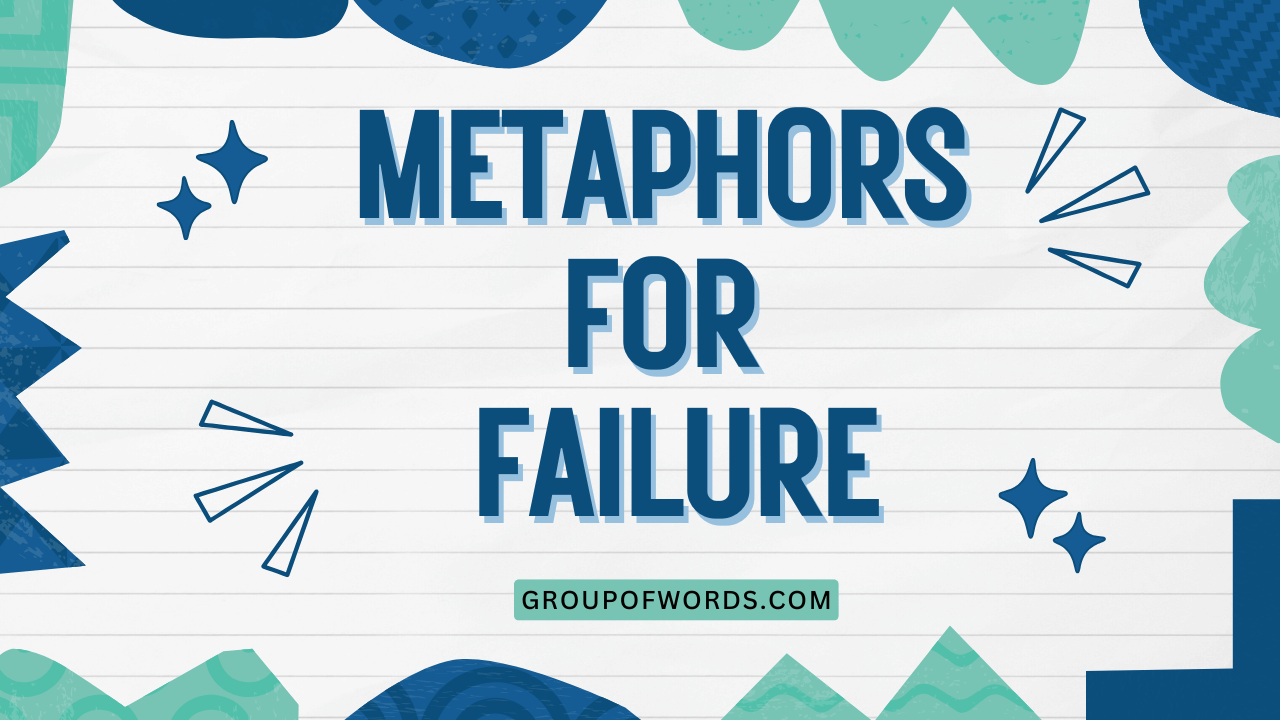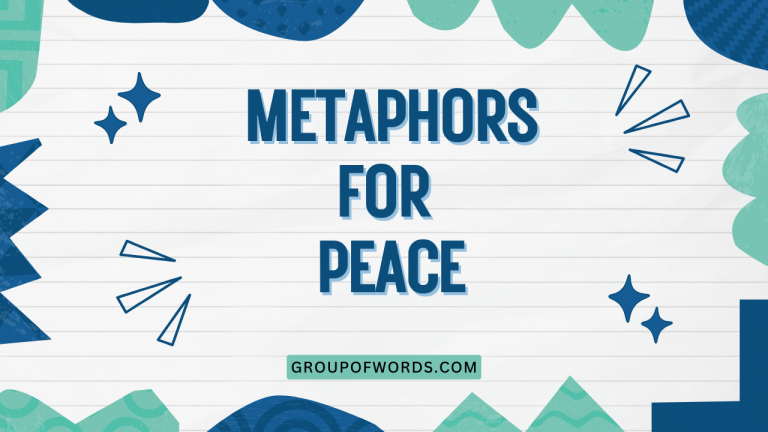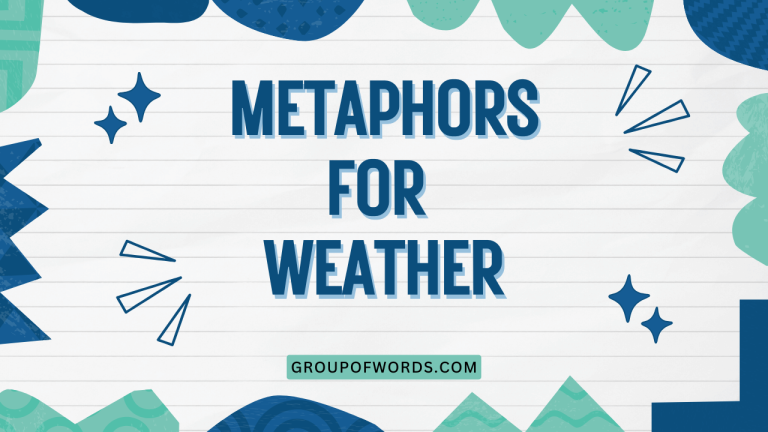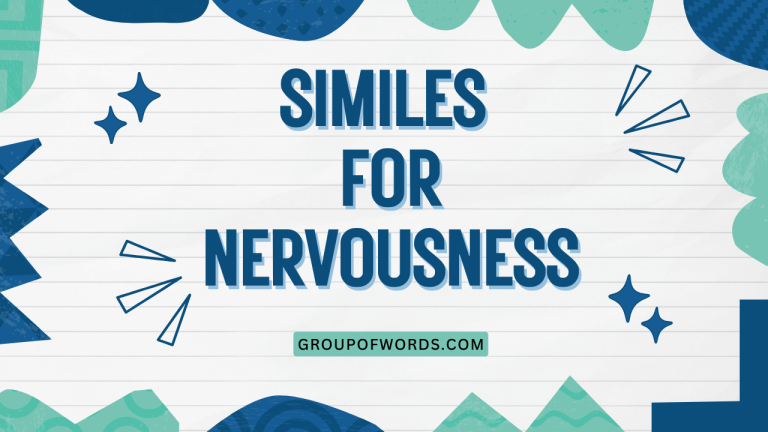Metaphors for Failure: A Comprehensive Guide
Understanding how we talk about failure is crucial for both effective communication and personal growth. Metaphors provide a powerful way to express complex emotions and experiences related to failure.
This article explores the rich landscape of metaphors used to describe failure in the English language. By examining these metaphors, we can gain a deeper understanding of the psychological and cultural attitudes surrounding failure.
This guide is designed for English language learners, writers, and anyone interested in exploring the nuances of language and its impact on our perceptions. This article will delve into the various types of metaphors used, provide numerous examples, and offer practical exercises to help you master this essential aspect of English vocabulary.
This article is structured to provide a comprehensive understanding of the topic, starting with a clear definition and progressing to more advanced concepts. Whether you are a student preparing for an exam, a professional looking to enhance your communication skills, or simply a language enthusiast, this article will provide valuable insights and practical tools to improve your understanding and use of metaphors for failure.
Table of Contents
- Introduction
- Definition of Metaphors for Failure
- Structural Breakdown of Failure Metaphors
- Types of Failure Metaphors
- Examples of Metaphors for Failure
- Usage Rules for Metaphors of Failure
- Common Mistakes When Using Failure Metaphors
- Practice Exercises
- Advanced Topics in Failure Metaphors
- Frequently Asked Questions
- Conclusion
Definition of Metaphors for Failure
A metaphor is a figure of speech that directly compares two unrelated things, asserting they are the same for rhetorical effect. Unlike similes, which use “like” or “as” to make a comparison, metaphors state that one thing *is* another.
When we talk about “metaphors for failure,” we are referring to the use of figurative language to describe instances where goals are not achieved, expectations are not met, or desired outcomes are not realized. These metaphors often draw parallels between failure and other concepts, such as physical collapse, financial ruin, natural disasters, or even illness.
The function of metaphors for failure is multifaceted. They serve to: simplify complex experiences, evoke emotional responses, add emphasis, and provide a new perspective on a challenging situation.
By framing failure in terms of something more familiar, we can better understand and process the experience. The contexts in which failure metaphors are used are varied, ranging from everyday conversations to business reports, academic analyses, and literary works.
Understanding these contexts is crucial for interpreting the intended meaning and impact of the metaphor.
For example, saying a business “crashed and burned” uses the metaphor of a plane crash to describe a severe business failure. This immediately conveys the severity and finality of the situation in a vivid and memorable way.
Similarly, describing a project as “dead in the water” uses a nautical metaphor to suggest that the project has no chance of success and is unlikely to be revived. These metaphors are not merely decorative; they are integral to how we conceptualize and communicate about failure.
Structural Breakdown of Failure Metaphors
The structure of a failure metaphor typically involves two key elements: the source domain and the target domain. The source domain is the concept or idea that is being used metaphorically (e.g., a shipwreck), while the target domain is the concept being described (e.g., a failed project). The metaphor works by mapping characteristics or attributes from the source domain onto the target domain, creating a new understanding of the latter.
For example, in the metaphor “His career imploded,” the source domain is implosion, a term often used in physics to describe a sudden inward collapse. The target domain is “his career,” referring to a person’s professional life. The metaphor maps the idea of a sudden, catastrophic collapse from the source domain onto the target domain, suggesting that the person’s career failed quickly and completely. Understanding this structural relationship helps in analyzing and interpreting the meaning of the metaphor.
The effectiveness of a failure metaphor depends on several factors. These include the clarity of the connection between the source and target domains, the emotional resonance of the source domain, and the overall context in which the metaphor is used.
A well-chosen metaphor can be incredibly powerful, while a poorly chosen one can be confusing or even misleading. It is important to consider the audience and the purpose of the communication when selecting a metaphor for failure.
The metaphor should resonate with the audience and accurately convey the intended message.
Types of Failure Metaphors
Metaphors for failure can be categorized based on the source domain from which they are drawn. Here are some common categories:
Physical Failure Metaphors
These metaphors use physical states or actions to describe failure. They often involve concepts like falling, breaking, collapsing, or being stuck.
These metaphors are particularly effective because they tap into our basic understanding of the physical world and our experiences with physical limitations.
Examples include: “His argument fell apart under scrutiny,” “The deal collapsed at the last minute,” and “The project stalled due to lack of funding.” These metaphors convey the idea that something has broken down or stopped functioning as intended.
Financial Failure Metaphors
These metaphors use financial terms to describe failure. They often involve concepts like bankruptcy, debt, loss, or inflation.
These metaphors are particularly common in business and economics contexts, but they can also be used to describe personal failures or setbacks.
Examples include: “The company went bankrupt,” “His hopes were devalued after the rejection,” and “The investment tanked.” These metaphors convey the idea that something has lost its value or is no longer viable.
Natural Disaster Failure Metaphors
These metaphors use natural disasters to describe failure. They often involve concepts like earthquakes, floods, storms, or droughts.
These metaphors are particularly powerful because they evoke a sense of chaos, destruction, and uncontrollability. They are often used to describe situations that are beyond human control or that have catastrophic consequences.
Examples include: “The scandal created a firestorm in the media,” “The project was flooded with problems,” and “His career went down like a house of cards.” These metaphors convey the idea that something has been overwhelmed by a sudden and destructive force.
War and Battle Failure Metaphors
These metaphors use war and battle to describe failure. They often involve concepts like defeat, surrender, casualties, or strategic errors.
These metaphors are particularly common in competitive contexts, such as business, politics, or sports. They evoke a sense of conflict, struggle, and ultimate defeat.
Examples include: “The company lost the battle for market share,” “His campaign suffered a major defeat,” and “The team surrendered to the superior opponent.” These metaphors convey the idea that someone has been overcome by an opposing force.
Health and Illness Failure Metaphors
These metaphors use health and illness to describe failure. They often involve concepts like disease, sickness, injury, or death.
These metaphors are particularly effective because they tap into our basic understanding of vulnerability, fragility, and mortality. They can be used to describe personal failures, relationship failures, or even organizational failures.
Examples include: “The relationship became toxic,” “The company is on life support,” and “His career died a slow death.” These metaphors convey the idea that something is deteriorating or has ceased to function.
Journey and Navigation Failure Metaphors
These metaphors use the imagery of journeys, navigation, and travel to describe failure. They often involve concepts like being lost, going off course, hitting a dead end, or sinking.
These metaphors are effective because they resonate with our inherent understanding of progress, direction, and the challenges of navigating through life. They can be used to describe both personal and professional setbacks.
Examples include: “The project went off the rails,” “Her career hit a dead end,” and “Their relationship sank.” These metaphors convey the idea that something has deviated from its intended path or has come to a standstill.
Examples of Metaphors for Failure
Here are some detailed examples of metaphors for failure, categorized by the types discussed above. Each table provides several examples to illustrate the range and versatility of these metaphors.
Physical Failure Metaphors Examples
The following table illustrates various ways physical actions and states are used metaphorically to describe failure.
| Metaphor | Meaning | Example Sentence |
|---|---|---|
| Fell apart | Disintegrated or failed due to flaws | The company’s plan fell apart when the economy weakened. |
| Collapsed | Failed suddenly and completely | The negotiations collapsed after weeks of progress. |
| Crumbling | Gradually deteriorating and failing | The old building was crumbling, symbolizing their failing business. |
| Stalled | Stopped progressing or developing | The project stalled due to lack of funding. |
| Cracked | Showed signs of weakness or failure | His composure cracked under the pressure of the investigation. |
| Shattered | Broken into pieces; completely ruined | Her dreams were shattered when she didn’t get the scholarship. |
| Crushed | Overwhelmed or defeated | His spirit was crushed by the constant criticism. |
| Imploded | Collapsed inward violently | The deal imploded when the investors pulled out. |
| Unraveled | Came undone; fell apart | The team’s strategy unraveled in the final quarter of the game. |
| Tumbled | Fell rapidly and uncontrollably | The stock price tumbled after the scandal was revealed. |
| Deteriorated | Gradually worsened | Their relationship deteriorated after years of neglect. |
| Eroded | Gradually worn away or destroyed | His confidence eroded after repeated failures. |
| Fractured | Broke or split apart | The team’s unity fractured after the disagreement. |
| Capsize | Overturned; failed completely | The startup capsized due to poor management. |
| Disintegrated | Broke apart into small pieces | The political coalition disintegrated after the election. |
| Subsided | Settled down; decreased | The initial excitement subsided when the challenges became apparent. |
| Withered | Declined or faded away | His enthusiasm withered after repeated setbacks. |
| Flattened | Reduced to nothing; completely defeated | Their hopes were flattened by the unexpected news. |
| Collapsed Under | Failed due to pressure or weight | The project collapsed under the weight of bureaucracy. |
| Broke Down | Ceased to function | The machine broke down at the most critical moment. |
| Cracked Under | Failed due to pressure | He cracked under the immense pressure of the competition. |
| Disintegrated | Broke apart into small pieces | The political coalition disintegrated after the scandal. |
| Dissolved | Broke apart into small pieces | Their promises dissolved when the crisis hit. |
Financial Failure Metaphors Examples
The table below illustrates various ways financial terms are used to metaphorically describe failure in different contexts.
| Metaphor | Meaning | Example Sentence |
|---|---|---|
| Went bankrupt | Failed financially | The company went bankrupt after the failed product launch. |
| Devalued | Lost value or importance | His opinion was devalued after his repeated mistakes. |
| Tanked | Failed or declined sharply | The stock price tanked after the negative earnings report. |
| Bottomed out | Reached the lowest point | The housing market bottomed out during the recession. |
| In the red | Operating at a loss | The project was in the red for the first two years. |
| Went bust | Failed financially; went bankrupt | Many small businesses went bust during the pandemic. |
| Liquidated | Sold off assets to pay debts | The company was forced to liquidate its assets. |
| Defaulted | Failed to meet financial obligations | The country defaulted on its debt payments. |
| Insolvent | Unable to pay debts | The company became insolvent due to poor management. |
| Deflated | Reduced in value or importance | His ego was deflated after the criticism. |
| Drained | Depleted of resources | The project was drained of its funding. |
| Invested poorly | Made bad choices | He invested poorly in his relationship, and it failed. |
| Lost equity | Failed to build success | He lost equity in his skills because he stopped practicing. |
| Overextended | Stretched beyond capacity | The company became overextended with too many projects. |
| Wasted capital | Failed to use resources wisely | They wasted capital on frivolous expenses. |
| Undercapitalized | Lacked sufficient funding | The startup was undercapitalized from the beginning. |
| Decline | Experienced a downturn | Her popularity declined after the scandal. |
| Diminished | Decreased in value | His reputation diminished after the accusations. |
| Plummeted | Fell rapidly | The sales plummeted during the economic downturn. |
| Shrunk | Became smaller or less significant | The company’s market share shrunk due to competition. |
| In arrears | Behind in payments | The project was in arrears due to budget cuts. |
| Deficit | A shortfall or deficiency | The team operated at a deficit of trust. |
| Sank | Failed financially | The business sank after the recession. |
Natural Disaster Failure Metaphors Examples
The following table provides examples of how natural disasters are used as metaphors to describe failure.
| Metaphor | Meaning | Example Sentence |
|---|---|---|
| Firestorm | Intense and widespread controversy | The scandal created a firestorm in the media. |
| Flooded | Overwhelmed with problems or difficulties | The project was flooded with problems from the start. |
| House of cards | A fragile or unstable system that collapses easily | His career went down like a house of cards after the scandal. |
| Earthquake | Sudden and disruptive event | The merger caused an earthquake in the industry. |
| Tsunami | Overwhelming and destructive force | The new regulations created a tsunami of paperwork. |
| Avalanche | A sudden and overwhelming amount of something | The company faced an avalanche of lawsuits. |
| Meltdown | A catastrophic failure | The nuclear reactor experienced a meltdown. |
| Eruption | A sudden and violent outburst | The conflict resulted in an eruption of anger. |
| Whirlwind | A chaotic and overwhelming situation | The new manager created a whirlwind of changes. |
| Quicksand | A situation that is difficult to escape from | The company found itself in quicksand after the scandal. |
| Volcanic | Potentially explosive or destructive | The situation was volcanic, ready to erupt at any moment. |
| Drought | A prolonged period of scarcity or lack | The company experienced a drought of innovation. |
| Blizzard | A sudden and overwhelming obstacle | The team faced a blizzard of criticism after the loss. |
| Landslide | An overwhelming defeat or failure | The election resulted in a landslide victory for the opposition. |
| Sinkhole | A hidden danger or problem that causes sudden failure | The project encountered a sinkhole of unexpected costs. |
| Storm | A period of intense difficulty or turmoil | The relationship weathered a storm of disagreements. |
| Tempest | A violent disturbance or turmoil | The news created a tempest of controversy. |
| Icestorm | A difficult and damaging situation | The company went through an icestorm of financial troubles. |
| Mudslide | A destructive and overwhelming force | The project was hit by a mudslide of unforeseen problems. |
| Aftershock | A secondary effect of an original issue | The company experienced aftershocks from the initial scandal. |
Usage Rules for Metaphors of Failure
Using metaphors effectively requires careful consideration of several factors. First, ensure that the metaphor is appropriate for the context and audience.
A metaphor that is too obscure or unfamiliar may be confusing or ineffective. Second, be consistent with the metaphor.
Mixing metaphors can create a jarring effect and undermine the clarity of your communication. Third, avoid clichés.
Overused metaphors can lose their impact and make your writing sound unoriginal.
For example, instead of saying “The project was a train wreck,” which is a common cliché, consider a more original metaphor like “The project went off the rails and plunged into the abyss.” This metaphor is more vivid and memorable. Also, be mindful of the emotional impact of your metaphors.
Metaphors for failure can be powerful tools for expressing disappointment, frustration, or even anger. However, they can also be hurtful or offensive if used carelessly.
Choose your metaphors carefully and consider the potential impact on your audience.
It’s also important to understand the cultural connotations of different metaphors. A metaphor that is effective in one culture may not be effective in another.
For example, metaphors related to sports or games may not resonate with people who are not familiar with those activities. Therefore, be aware of the cultural background of your audience and choose metaphors that are likely to be understood and appreciated.
Common Mistakes When Using Failure Metaphors
One common mistake is using mixed metaphors, which occurs when you combine two or more incompatible metaphors in the same sentence or passage. This can create confusion and undermine the clarity of your message.
For example, saying “The project was a sinking ship that hit the ground running” combines a nautical metaphor with a running metaphor, resulting in a nonsensical image.
Another common mistake is using clichés or overused metaphors. These metaphors have lost their impact and can make your writing sound unoriginal.
For example, saying “The company was circling the drain” is a common cliché that should be avoided. A better alternative might be “The company was spiraling downward, facing imminent collapse.” Furthermore, misinterpreting the original meaning or context of a metaphor can lead to inaccurate or inappropriate usage.
Always ensure you fully understand the implications and nuances of a metaphor before using it.
Here’s a table illustrating common mistakes with failure metaphors:
| Incorrect | Correct | Explanation |
|---|---|---|
| The project was a sinking ship that hit the ground running. | The project was a sinking ship. OR The project hit the ground running but quickly ran out of steam. | Avoid mixing metaphors. Choose one consistent image. |
| The company was circling the drain. | The company was spiraling downward, facing imminent collapse. | Avoid clichés. Opt for more original and vivid language. |
| His career exploded. (when it slowly declined) | His career slowly withered and died. | Ensure the metaphor accurately reflects the situation. |
Practice Exercises
Test your understanding of metaphors for failure with these exercises. Each question requires you to identify or create a metaphor that accurately describes a given scenario.
Exercise 1: Identifying Metaphors
Identify the metaphor used in each sentence and explain its meaning.
| Question | Answer |
|---|---|
| 1. The deal collapsed under the weight of legal issues. | The metaphor is “collapsed under the weight.” It means the deal failed because it was overwhelmed by legal problems. |
| 2. His hopes were dashed against the rocks of reality. | The metaphor is “dashed against the rocks.” It means his hopes were destroyed by harsh realities. |
| 3. The company’s profits tanked after the scandal. | The metaphor is “tanked.” It means the company’s profits decreased sharply. |
| 4. The project went off the rails due to mismanagement. | The metaphor is “went off the rails.” It means the project deviated from its intended course and failed. |
| 5. Her dreams shattered like glass when she failed the exam. | The metaphor is “shattered like glass.” It means her dreams were completely ruined. |
| 6. The negotiation was a dead end. | The metaphor is “dead end.” It means the negotiation reached a point where no further progress was possible. |
| 7. The business was on life support, barely surviving. | The metaphor is “on life support.” It means the business was in critical condition and needed help to survive. |
| 8. The company’s reputation went up in flames after the scandal. | The metaphor is “went up in flames.” It means the company’s reputation was severely damaged or destroyed. |
| 9. His arguments fell apart under scrutiny. | The metaphor is “fell apart.” It means his arguments were weak and could not withstand examination. |
| 10. The team’s morale plummeted after the defeat. | The metaphor is “plummeted.” It means the team’s morale decreased rapidly and significantly. |
Exercise 2: Creating Metaphors
Create a metaphor to describe the following scenarios of failure.
| Scenario | Possible Metaphor |
|---|---|
| 1. A startup company runs out of funding and closes down. | The startup ran out of fuel and crashed. |
| 2. A politician’s career is ruined by a scandal. | The politician’s career became a toxic waste dump. |
| 3. A sports team loses a crucial game due to poor strategy. | The team’s strategy was a house of cards, collapsing under pressure. |
| 4. A student fails an important exam despite studying hard. | The student’s efforts were a dam that broke under the weight of the exam. |
| 5. A long-term relationship ends due to constant arguments. | The relationship became a battlefield of constant conflict. |
| 6. A project is delayed indefinitely due to bureaucratic hurdles. | The project became mired in a bureaucratic swamp. |
| 7. An innovative idea is rejected by the board of directors. | The innovative idea was shot down in flames by the board. |
| 8. A company’s market share decreases due to increased competition. | The company’s market share was eroded by the rising tide of competition. |
| 9. A once-successful product becomes obsolete due to technological advancements. | The product became a dinosaur in the digital age. |
| 10. A carefully planned event is ruined by unexpected weather conditions. | The planned event was washed away by an unexpected storm. |
Advanced Topics in Failure Metaphors
At an advanced level, consider the use of extended metaphors, where a single metaphor is developed and sustained throughout a longer passage or text. This can create a powerful and cohesive effect, but it requires careful planning and execution.
Also, explore the use of irony and satire in failure metaphors, where the intended meaning is the opposite of the literal meaning. This can be a subtle and effective way to critique or comment on a situation.
Analyzing how different authors and speakers use failure metaphors can provide valuable insights into their style and perspective. Pay attention to the specific metaphors they choose, the context in which they are used, and the overall effect they create.
Finally, consider the ethical implications of using failure metaphors. Be mindful of the potential to stigmatize or dehumanize individuals or groups who have experienced failure.
Use metaphors responsibly and with sensitivity.
Another advanced concept is the idea of “conceptual metaphors,” which are underlying cognitive structures that shape our understanding of abstract concepts. For example, the conceptual metaphor “ARGUMENT IS WAR” explains why we often use war-related language when discussing arguments (e.g., “He attacked my points,” “I defended my position”).
Understanding conceptual metaphors can provide a deeper understanding of how we think and communicate about failure.
Frequently Asked Questions
Here are some frequently asked questions about metaphors for failure:
- What is the difference between a metaphor and a simile?
A metaphor directly compares two unrelated things, stating that one thing *is* another (e.g., “His career was a train wreck”). A simile uses “like” or “as” to make a comparison (e.g., “His career was like a train wreck”).
- Why are metaphors for failure important?
Metaphors for failure help us understand and communicate complex emotions and experiences related to failure. They can simplify complex situations, evoke emotional responses, and provide new perspectives.
- How can I avoid using clichés when using failure metaphors?
Be creative and original in your choice of metaphors. Think about the specific aspects of the failure you want to emphasize and choose a metaphor that accurately reflects those aspects. Avoid overused phrases like “sinking ship” or “train wreck.”
- What are some common categories of failure metaphors?
Common categories include physical failure metaphors, financial failure metaphors, natural disaster failure metaphors, war and battle failure metaphors, health and illness failure metaphors, and journey and navigation failure metaphors.
- How can I use metaphors for failure effectively?
Choose metaphors that are appropriate for the context and audience. Be consistent with your metaphors. Avoid clichés. Be mindful of the emotional impact of your metaphors.
- What are some common mistakes to avoid when using failure metaphors?
Avoid mixed metaphors, clichés, and misinterpreting the original meaning of a metaphor. Ensure that your metaphors are accurate and appropriate for the situation.
- Can metaphors for failure be offensive?
Yes, if used carelessly or insensitively. Be mindful of the potential to stigmatize or dehumanize individuals or groups who have experienced failure. Use metaphors responsibly and with empathy.
- How do cultural differences affect the use of failure metaphors?
Metaphors can have different meanings and connotations in different cultures. Be aware of the cultural background of your audience and choose metaphors that are likely to be understood and appreciated.
Conclusion
Metaphors for failure are a powerful tool for understanding and communicating about challenging experiences. By mastering the art of using these metaphors, you can enhance your communication skills and gain a deeper appreciation for the nuances of the English language.
Remember to choose your metaphors carefully, be consistent in their use, and avoid clichés. Consider the context, audience, and potential emotional impact of your metaphors.
With practice and attention to detail, you can use metaphors for failure to express complex ideas and emotions in a vivid and memorable way.
As you continue to explore the world of metaphors, remember that language is a dynamic and ever-evolving tool. Be open to new and creative ways of expressing yourself, and always strive to communicate with clarity, accuracy, and sensitivity.
By embracing the power of metaphors, you can unlock new possibilities for understanding and connecting with others, even in the face of failure. Keep practicing and refining your skills, and you will find that the ability to use metaphors effectively will become a valuable asset in both your personal and professional life.






